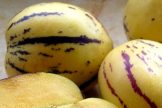
 Important note about plant availability. Important note about plant availability.There are hundreds of factsheets on our website provided for your information. Not all plants will be available at all times throughout the year. To confirm availability please call (03) 8850 3030 and ask for the nursery. |
The burst of flavour from a home grown melon is a lesson in why we grow our own fruit. Couple that with the slightly smug satisfaction in picking your own and it is a glorious summer gift to the dining table. On its own, in fruit salad, with salt (thanks Dad), with sugar, wrapped in prosciutto or naked, melons are the best!
Planting / Sowing
Prepare the soil in advance by digging through manure and compost. They need plenty of room for the vines to spread so keep plants a minimum of 1m apart. If space is an issue, melons can be trained up a trellis using soft ties (stocking or hessian webbing). This has the advantage of allowing good airflow and keeping melons free of dirt. Melons are frost tender, plant after last spring frost is over and the soil is warming up. They need a fairly long growing season (2 months minimum), don’t delay too long getting them into the ground. Melons are sun lovers, they can manage a bit of shade, but the sunnier the better.
Growing
You want the vines to branch out, so pinch out the growing tips once a minimum of three leaves have appeared. You can do this on the main growing tip and then on the side shoots.
If the flowers are opening and then dying off without setting fruit, then the bees are busy elsewhere and you may need to hand pollinate. Once fruit has set, give the roots a liquid feed and sprinkle some manure based fertiliser around. Melons are not drought tolerant vines, their big leaves and fruit need plenty of water. On a hot summer day the leaves will often wilt a bit, but they should pick up in the evening, if they are still wilted, you need to apply more water. Watering well is crucial to getting good frim juicy fruit. However, that said, don’t drown them, good drainage is important also. Melons, pumpkins, cucumbers etc are all prone to powdery mildew and other fungal issues, minimise this by watering using soakers or drippers to avoid wetting the leaves, but if using sprinklers, water in the morning, this allows leaves to rapidly dry off during the day. As the melons get close to ripening, the leaves start to look a bit shabby, don’t worry, this is normal.
Harvesting
The fruits will continue to ripen after they are harvested. They are ready once the stalk starts to shrivel and the fruit pulls away easily. Once all fruit are off, chop up the old vines and compost, or bin if too full of powdery mildew to safely go into the compost.




